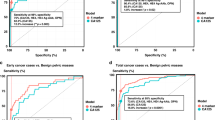Abstract
Objective
The purpose of this study was to evaluate the expression of a novel autologous ovarian tumor-associated antigen in eight human ovarian tumor cell lines compared with other ovarian tumor markers and products of oncogenes.
Methods
Autologous antibodies were eluted from human ovarian tumor-membrane fragments purified in our laboratory. These antibodies react with autologous ovarian tumor-associated antigens (AOTA) and have a high degree of specificity for human ovarian tumors. They do not bind to normal ovarian or nonovarian tissues, or to nonovarian neoplastic tissues. We evaluated eight human ovarian adenocarcinoma cell lines (2008, 2774, Caov-3, OVCAR-3, PA-1, SW 626, UCI 101, and UCI 107) by indirect immunofluorescence to determine the expression of AOTA relative to the ovarian cancer tumor marker CA 125 and the products of selected oncogenes (p53, c-neu, and c-myc).
Results
The patterns and intensities of immunofluorescence correlated most closely between AOTA and c-neu. For example, AOTA and c-neu were detected in all eight cell lines and displayed very strong cytoplasmic fluorescence on cell lines 2774, UCI 101, and UCI 107. CA 125 was present in the cytoplasm of four of eight cell lines. A tumor suppressor gene product, p53, exhibited a nuclear staining pattern in six of eight cell lines.
Conclusions
These data suggest that AOTA and the products of the c-neu oncogene may share certain epitopes. Current studies are underway to increase our understanding of the humoral response to ovarian cancer and the possible relationship to the expression of tumor oncogene products. Further characterization of AOTA will be necessary before early diagnostic tests can be dereloped. (J Soc Gynecol Invest 1996;3: 216-22)
Similar content being viewed by others
References
Wingo PA, Tong T, Bolden S. Cancer statistics, 1995. CA 1995;45:8–30.
Herbst AL. The epidemiology of ovarian cancer and the current status of tumor markers to detect disease. Am J Obstet Gynecol 1994;170:1099–107.
Urban JL, Schreiber H. Tumor antigens. Ann Rev Immunol 1992;10:617–44.
McKenzie SJ, DeSombre KA, Bast BS, et al. Serum levels of HER-2 neu (C-erbB-2) correlate with overexpression of p185neu in human ovarian cancer. Cancer 1993;71:3942–6.
Borresen AL. Oncogenesis in ovarian cancer. Acta Obstet Gynecol Scand 1992;155:25–30.
Berchuck A, Kohler MF, Marks JR, Wiseman R, Boyd J, Bast RC. The p53 tumor suppressor gene frequently is altered in gynecologic cancers. Am J Obstet Gynecol 1994;170:246–52.
Bast RC, Feeney M, Lazarus H. Reactivity of a monoclonal antibody with human ovarian cancer. J Clin Invest 1981;68:1331–7.
Dawson JR, Kutteh WH, Whnesides DB, Gall SA. Identification of tumor-associated antigens and their purification from cyst fluids from ovarian and epithelial neoplasms. Gynecol Oncol 1980;10:6–17.
Knauf S, Urbach GI. A study of ovarian cancer patients using a radioimmunoassay tor human ovarian tumor-associated antigen OCA. Am J Obstet Gynecol 1980;138:1222–3.
Bhattacharya M, Chatterjee SK, Barlow JJ, et al. Monoclonal antibodies recognizing tumor-associated antigen of human ovarian mucinous cystadenocarcinomas. Cancer Res 1982;42:1650–4.
Kutteh WH, Welander CE, Homesley HD, Doellgast GF. Autologous antibodies eluted from membrane fragments isolated from the effusions of human ovarian epithelial neoplasia. I. Quantitation of antibodies. Am J Obstet Gynecol 1985;153:124–9.
Kutteh WH, Doellgast GJ. Autologous antibodies eluded from membrane fragments in human ovarian epithelial neoplastic effusions. II. Tissue specificity and reactivity. J Nat Cancer Inst 1986;76:797–804.
Kutteh WH, Baker VV, Doellgast GJ. Autologous antibodies eluted from membrane fragments in human ovarian epithelial neoplastic effusions. HI. Cytotoxic potential in vitro and characterization of antigen(s). Am J Obstet Gynecol 1990;163:1301–6.
Giancotti FR, Dorsett BH, Qian H, Cronin WJ, Barber HRK, Ioachim HL. Ovarian cancer-associated antibodies recovered from ascites: Their use for the isolation of ovarian cancer-associated antigen to produce monoclonal antibodies. Gynecol Oncol 1990;37:24–8.
Lutz PM, Dawson J. Activity of antibodies recovered from immune complexes of ovarian cancer patients. Cancer Immunother 1984;17:188–9.
Sotomayor EM, Fu Y-X, Lopez-Cepero M. et al. Role of tumor-derived cytokines on the immune system of mice bearing a mamillary adenocarcinoma. II. Down-regulation of macro-phage-mediated cytotoxicity by tumor-derived granulocyte-macrophage colony-stimulating factor. J Immunol 1991;147:2816–23.
Black PH. Shedding from the cell surface of normal and cancer cells. Adv Cancer Res 1980;32:75–199.
Courtenay-Luck NS, Epenetos AA, Sivolapenko GB, Larche M, Barkans JR, Ritter MA. Development of anti-idiotypic antibodies against tumor antigens and autoantigens in ovarian carrier patients treated intrapentoneally with most monoclonal antibodies. Lancet 1988;ii:894–6.
Subba-Rao G, Hanjani P. Detection of human tumor-associated antigens by antibodies isolated from ovarian carcinoma ascitic fluid. Am J Obstet Gynecol 1988;159:94–8.
Meden H, Marx D, Fattahi A. et al. Elevated serum levels of a C-erbB-2 oncogene product in ovarian cancer patients and in pregnancy. J Cancer Res Clin Oncol 1994;120:378–81.
Yaginuma Y, Westphal H. Abnormal structure and expression of the p53 gene in human ovarian carcinoma cell lines. Cancer Res 1992;52:4196–9.
Bast RC, Boyer CM, Jacobs I, et al. Cell growth regulation in epithelial ovarian cancer. Cancer 1993;74:1597–601.
Rubin SC, Finstad CL, Federici MG, Scheiner L, Lloyd KO, Hoskins WJ. Prevalence and significance of HER-2/neu expression in early epithelial ovarian cancer. Cancer 1994;73:1456–9.
Katsaros D, Theillet C, Zola P, et al. Concurrent abnormal expression of erbB-2, myc. and ras genes is associated with poor outcome of ovarian cancer patients. Anticancer Res 1995;15:1501–10.
Author information
Authors and Affiliations
Rights and permissions
About this article
Cite this article
Kutteh, W.H., Miller, D.S. & Mathis, J.M. Immunologic Characterization of Tumor Markers in Human Ovarian Cancer Cell Lines. Reprod. Sci. 3, 216–222 (1996). https://doi.org/10.1177/107155769600300409
Published:
Issue Date:
DOI: https://doi.org/10.1177/107155769600300409




